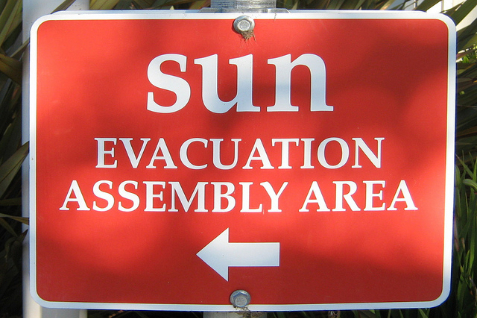Not every emergency requires an evacuation, but having a clear procedure for removing people from danger is a core element of any workplace emergency plan. Even if an accident emergency is confined to a specific area, staff and visitors will need to be removed swiftly and without delay, and to accomplish this, people need to know where to go immediately.
Of course, a PCBU, first aider or other appointed member of staff needs to be well versed in any evacuation procedure, so that instruction can be given to the people present.
However, it is equally a good idea that all workers – whether on the shop floor or in the administration office – know where to go. Clearly, office staff need a different evacuation route to those in the warehouse, for example. Knowing how to reach a safe area from each individual work area is vital.
It is also important that more than one evacuation route is selected from each work area. This is because the emergency itself might mean that Route A is blocked, so a Route B and even a Route C may be necessary. When drawing up the evacuation plan, all possible scenarios should be examined.
Training and Practice
Also, and perhaps most importantly, providing proper training to relevant staff is hugely important. First aiders and PCBUs are often those chosen, but whoever it is must know immediately how to oversee the evacuation procedure, calmly provide instruction and be fully aware of alternative options if needed and be able to communicate them to evacuating staff.
This is where simulations and practice evacuations are so valuable. Running a simulated evacuation on a quarterly basis helps ensure that everyone is clear on what must be done and what route to take.
Some Key Points to Consider
1. Identify Risks and Options
- Identify the emergencies that may require an evacuation
- Identify the safe areas to guide staff to – car park, garden etc
- In urban areas, avoid evacuating onto a busy street, if possible
2. Make Routes Known
- Make chosen routes clear to see, with signs, arrows etc
- Use illuminated exit signs and route arrows in case of power blackouts
- Ensure the routeway is properly illuminated too – check the lights are working
- Draw up an evacuation route map for each work area, and place them in prominent areas
3. Alarms and Equipment
- Alarm bells or sirens should be installed to notify all staff to begin evacuation
- Ensure fire detection equipment is working and is regularly maintained
- In the case of non-fire related emergencies, ensure the bell or siren can be set off manually from strategic locations around the premises
- Ensure regular maintenance and testing is carried out on all emergency equipment
4. Staff Considerations
- Consider location of all staff members – groups and individuals
- Consider staff members with special needs (hearing or sight impairment, wheelchair bound)
- To account for all staff, delegate head counting responsibilities in each area (office, work floor, warehouse etc)
- Practice the procedure, with quarterly dedicated evacuation simulations
For further reading on Emergency Plans and how to go about drawing them up, check out the official Safe Work Australia PDF file: www.safeworkaustralia.gov.au/AboutSafeWorkAustralia/WhatWeDo/Publications/Documents/657/Emergency_plans_fact_sheet.pdf
Time is very important especially when it is between life and death. With Alsco we can supply your business with a managed Automated External Defibrillator (AED) service to ensure you have access to a high quality, affordable Automated External Defibrillator at all times. We also offer fully managed First Aid Supply and Service Kit designed to ensure ongoing WH&S compliance for your business.
Make your own workplace safer. Give Alsco a call. What are you waiting for?
View Previous Posts in this Series:
- Part 1 – Workplace Emergency Plans: What You Need to Know
- Part 2 – Types of Workplace Emergency Plans: Points to Consider
Image Courtesy: Richard Masoner


LEAVE A REPLY
Your email address will not be published. Required fields are marked *
You must be logged in to post a comment.